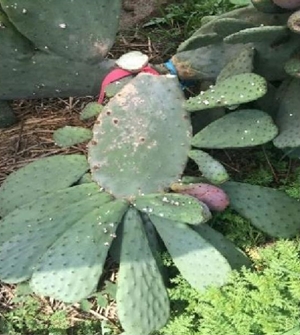Serviços Personalizados
Journal
Artigo
Indicadores
-
 Citado por SciELO
Citado por SciELO -
 Acessos
Acessos
Links relacionados
-
 Similares em
SciELO
Similares em
SciELO
Compartilhar
Revista mexicana de ciencias agrícolas
versão impressa ISSN 2007-0934
Rev. Mex. Cienc. Agríc vol.11 no.3 Texcoco Abr./Mai. 2020 Epub 30-Ago-2021
https://doi.org/10.29312/remexca.v11i3.1995
Articles
Floral stimulation in prickly pear cactus in response to the effect of Thidiazuron
1Postgrado en Recursos Genéticos y Productividad-Fruticultura. Colegio de Postgraduados. Carretera México-Texcoco km 36.5, Montecillo (emanuel-tez-15@hotmail.com; djaen@colpos.mx).
2Postgrado en Edafología Colegio de Postgraduados. Carretera México-Texcoco km 36.5, Montecillo (jicortes@colpos.mx).
3Postgrado en Estadística. Colegio de Postgraduados. Carretera México-Texcoco km 36.5, Montecillo, Texcoco, Estado de México. CP. 56230. Tel. 55 5804 5933. (sjavier@colpos.mx).
On average, the yield of prickly pear Opuntia ficus-indica (L.) Mill. is low, being 5.5 t ha-1 year-1. The prickly pear cactus cladodes have only budding in the periphery, representing 30% of total sprouts/cladode, wasting the lateral spaces of the stem. Employing biostimulant in conjunction with plastic cover and irrigation to increase flower budding and yield is the objective of this research. 4-year-old ‘Roja purpura’ cactus plants were used, with a planting distance of 3 x 4 m. There were two factors: 1) Thidiazuron dose: 0 ppm, 400 ppm, 800 ppm. 2) Joint plastic cover with irrigation: without cover and without irrigation, without cover and with irrigation, with irrigation and without cover, with irrigation and with cover, in a 3x4 factorial arrangement, with 12 treatments and three repetitions in divided plots. The experimental unit was a group of four cladodes. At 44 days after applying Thidiazuron, the 800 ppm TDZ treatment obtained a higher percentage of flower sprouts with 53.9%, followed by irrigation cover and 400 ppm of TDZ with 46.8%, exceeding 12.7% of the control. Twenty-two days after the application of TDZ, the plants with plastic cover began to revert flower sprouts to vegetative, this phenomenon and the appearance of new sprouts, both vegetative and floral, stopped 44 days after applying TDZ, this suggests that the cover at raising and maintaining high temperature could stimulate vegetative sprouting and cause floral reversal.
Keywords: cladode; floral reversal; lateral sprouting
En promedio, el rendimiento de tuna Opuntia ficus-indica (L.) Mill. es bajo, siendo 5.5 t ha-1 año-1. Los cladodios de nopal tunero tienen únicamente brotación en la periferia, representando 30% de brotes totales/cladodio, desaprovechando los espacios laterales de la penca. Emplear bioestimulante en conjunto con cubierta plástica y riego para aumentar brotación floral y rendimiento es el objetivo de esta investigación. Se usaron plantas de nopal tunero ‘Roja purpura’ de 4 años de edad, con distancia de plantación de 3x4 m. Se tuvieron dos factores: 1) dosis de Thidiazurón: 0 ppm, 400 ppm, 800 ppm. 2) cubierta plástica conjunta con riego: sin cubierta y sin riego, sin cubierta y con riego, con riego y sin cubierta, con riego y con cubierta, en arreglo factorial 3x4, con 12 tratamientos y tres repeticiones en parcelas divididas. La unidad experimental fue un grupo de cuatro cladodios. A 44 días después de aplicar Thidiazurón, el tratamiento 800 ppm de TDZ, obtuvo mayor porcentaje de brotes florales con 53.9%, seguido por cubierta con riego y 400 ppm de TDZ con 46.8%, superando 12.7% del testigo. Veintidós días después de la aplicación de TDZ, las plantas con cubierta plástica comenzaron a revertir yemas florales a vegetativas, este fenómeno y la aparición de nuevos brotes, tanto vegetativos como florales se detuvieron 44 días después de aplicar TDZ, esto sugiere que la cubierta al elevar y mantener la temperatura alta pudo estimular brotación vegetativa y ocasionar reversión floral.
Palabras clave: brotación lateral; cladodio; reversión floral
Introduction
The prickly pear cactus Opuntia ficus-indica (L.) Mill. is distributed in America, and Mexico occupies the first place in cultivated area with 65 000 ha-1, having more than 20 000 producers, it has a greater diversity of species and varieties, the most outstanding are: ‘Alfajayucan’, ‘Cristalina Blanca’, ‘Amarilla’ and ‘Roja’. National production shows upward trends, since from 1980 to 2015 it went from 43 000 t to 408 000 t (SIAP, 2016). Nopal is the most important fruit tree in arid and semi-arid areas of Mexico, due to its physiological and morphological characteristics that allow it to adapt to extreme conditions of high or low temperatures and water scarcity (Gallegos and Méndez, 2000).
The producers of prickly pear in the country obtain low income from the harvest, due to two problems: 1) Low yields (Márquez et al., 2012). Producers from the states of Mexico, Puebla and Hidalgo are harvesting about 5.5 t ha-1, considering themselves a regular production, and producers with availability of water and economic resources obtain up to 20.5 t ha-1 (Domínguez et al., 2017); and 2). The prickly pear is harvested mainly in the months of July to September; however, demand and price are higher in December (Ramírez et al., 2015). Some foreign and national researchers have carried out works addressing the aforementioned problems; for example, Martínez et al. (2001), in order to increase the yield, they evaluated the effect of pruning and the period of emergence of one-year-old cladodes, from the cactus of ‘Alfajayucan’, removing 25, 50 and 75% of the cladode
To stimulate floral voting on both sides of the racket, since sprouts generally emerge on the upper periphery of the cladode, representing 30% of the vote. At the same time that with this practice the size of the plants is reduced and the larger the tip of the cladode is, the greater the decrease in yield, eliminating 25% of the cladode, the yield decreases 32%, with 50% blunted it decreases 67% and removing 75% reduced the yield 93%.
On the other hand, Aguilar (2005) evaluated the response of the ‘Tlaconopal’ prickly pear cactus to partial ringing in cladodes, finding a 50% increase in yield, and also advanced the harvest by 51 days. Other studies have focused on evaluating the effect of irrigation on prickly pear cactus, Luna et al. (2012) found that, with drip irrigation applying 67 L plant-1 month-1 at the beginning of the floral and vegetative sprouting and before harvest, the yield is increased by 36.7% or more.
Other studies such as those by Muñoz et al. (1994) evaluated the effect of plastic covers in microtunnels with irrigation in nopal vegetable to increase yield and maintain production in winter. Their results showed that the yield did not increase, but it maintained production in winter, and they also found a positive relationship between the effect of the temperature produced by the microtunnel cover with the number of cut cladodes.
Despite the results obtained, no increase in yield has been found without side effects, such as the advance of the harvest, in conditions of limited rainy season or reducing the quality of fruits, so this work aimed to stimulate flower budding side of the cladodes using a biostimulant at different doses, under different plant growth conditions.
Materials and methods
The experiment was carried out in the San Jose orchard in the experimental field of the College of Postgraduates Campus Montecillo, Municipality of Texcoco, State of Mexico, located at a north latitude of 19° 27’ 34.31” and west longitude 98° 54’ 21.03”, 2 247 masl , with a semi-dry temperate climate, maximum temperature of 27.1 °C and minimum of 1.1 °C, relative humidity of 43% and annual precipitation of 551.2 mm (meteorological station, Campus Montecillo of the Colegio de Postgraduados, 2018).
Vegetal material
The study was carried out on the ‘Roja púrpura’ selection chosen for its outstanding fruit characteristics, which are: red flesh, average weight of 150 g, moderately resistant to post-harvest handling. The age of the plants is 4 years, and they are established at 3 x 4 m between plants and rows, respectively. The period from flower bud to maturity of consumption is approximately 140 days.
Treatment design and experimental design
Two factors were evaluated: 1) Thidiazuron biostimulant at three levels (0, 400 and 800 ppm) and 2) plastic cover with irrigation at four levels (without cover and without irrigation, without cover and with irrigation, with irrigation and without cover, with irrigation and with cover), so there was a 3 x 4 factorial arrangement, generating 12 treatments, with three repetitions, the experimental unit was a group of four cladodes that received the same treatment, the experimental design was divided plots, where the large plot was the partial canopy cover with the emergency irrigation and the small plot was the TDZ dose.
Establishment and management of the experiment
In January 2018 12 plants of prickly pear cactus were selected with a minimum of 12 cladodes a year of growth to form three groups of four cladodes per plant receiving the same treatment. The selection criteria were based primarily on cladodes positioned vertically and with the lateral faces facing north-south, due to the fact that they received more solar radiation.
Thidiazuron application
One day before applying the treatments, a solution was prepared with 20% garlic oil from the San Lucas brand. 15% commercial product was mixed with 7.5 ml of BayerMR Inex-A surfactant. On February 14, 2018, two mixtures were prepared, using the mixture of garlic oil with Inex-A as the base components of these, 400 ppm of the 50% BayerMR TDZ biostimulant was added to the first, and the second 800 ppm of it. product, both were finally graduated at 1 L, with 500 mL of prickly pear mucilage diluted in tap water.
Installation of plastic covers and irrigation application
The partial canopy cover was made with 700 gauge plastic and 20% shade. The irrigation was done manually, depositing the water in bowls of 1m long, 1m wide and 15cm high. After the first irrigation (March, 2018), the 15cm deep bowl was covered with barley straw, this in order to retain moisture, the irrigations were applied once a month until July 2018, providing 30 L plant-1 month-1 to each cajete.
Temperature record outdoors and under plastic cover
Three daily readings of average temperature, outdoors and under plastic cover were recorded, using Steren model Ter-150a portable digital thermometers model 150-150 m high. The readings were at 8:00, 14:00 and 19:00.
Percentage of vegetative and flower sprouts
Fifteen days after the application of the treatments, the first sprouts emerged, weekly counts were made for 44 days of the total meristems sprouted from each cladode and they were converted to a percentage considering the total areolas per cladode (Figure 1).
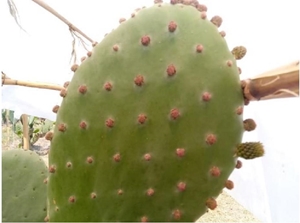
Figure 1 Budding of flower and vegetative sprouts 30 days after TDZ application at a dose of 400 ppm.
The floral and vegetative meristems were also differentiated. According to Pimienta et al. (1993) when a prickly pear cactus sprout emerged, it is differentiated by the shape of the upper part of the bud: floral (round) or vegetative (rectangular).
Statistical analysis
An analysis of variance and comparison of means was carried out with the Tukey test, with a reliability level of p≤ 0.05 for the response variable, the Statistical Analysis Software program, version 9.4 was used. (SAS Institute, 2013).
Results and discussion
Regarding air temperature, it was found that it was higher with the plastic cover (Figure 2b), being 3 to 8 °C higher than outdoors (Figure 2a), in the months of April, May, June and July. The temperature difference was probably related to the floral reversal that is discussed later.
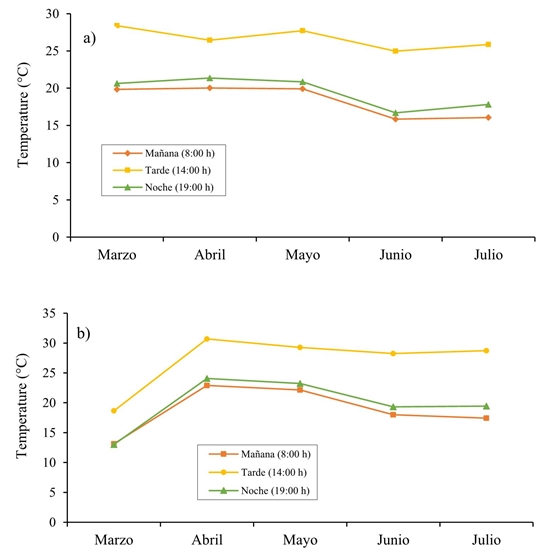
Figure 2 Average monthly temperature. a) outdoors; and b) under plastic cover, from emergence of sprouts, to physiological maturity of the fruit.
Percentage of flower and vegetative sprouts
The analysis of variance indicates that there were differences (p≤ 0.5) between treatments due to the effect of TDZ and the growth conditions of the plant: canopy cover, irrigation or combination of both in the percentage of vegetative and flower sprouts. 15 days after the application of TDZ, the start of sprouting was observed in the cladodes with the application of TDZ under the different growth conditions. With irrigation and 800 ppm of TDZ, the highest percentage of vegetative sprouts was obtained, being 12.7% (Figure 3a).
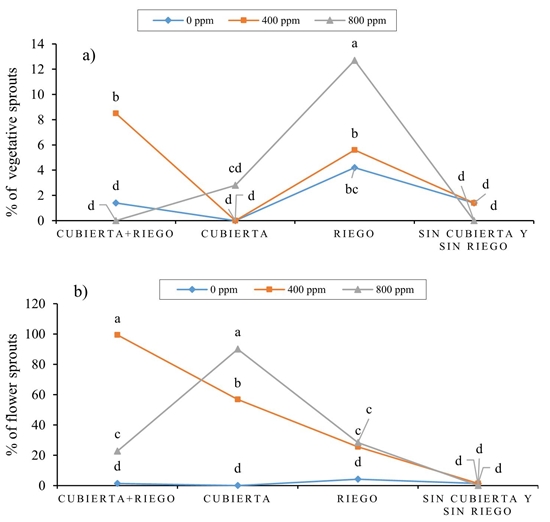
Figure 3 Percentage of vegetative sprouts (a); and flowers (b) 15 days after TDZ application under four management conditions. Equal letters are not statistically significant Tukey (p≤ 0.05).
The percentage of flower sprouts (Figure 3b) was higher with the use of cover and irrigation with the dose of 400 ppm of TDZ, since it stimulated 99.4% of budding, followed by treatment with cover and 800 ppm of TDZ with 90.8%. Twenty-two days after the application of TDZ, the prickly pear cactus plants under irrigation conditions and the application of 800 ppm of TDZ showed a higher percentage of vegetative sprouting with 21.3% (Figure 4a), while the percentage of flower sprouts decreased.
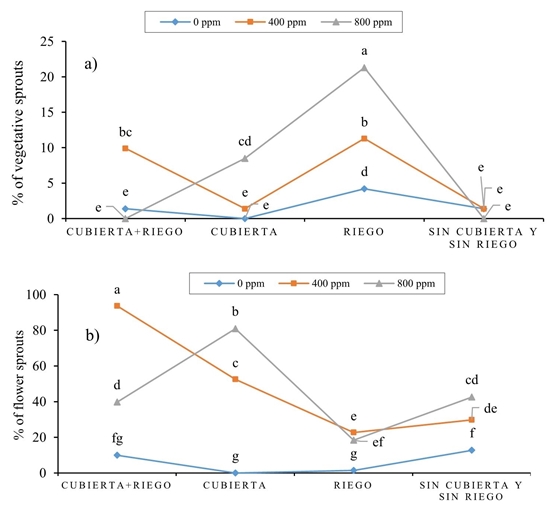
Figure 4 Percentage of vegetative sprouts (a); and flowers (b) 22 days after the application of the dose of TDZ and plastic cover with irrigation in prickly pear cactus ‘Roja purpura’. The lines represent the means and the equal letters are not statistically significant Tukey (p≤ 0.05).
Using cover and irrigation with 400 ppm of TDZ the percentage was 99.4 (Figure 3b) against 93.7% counted 7 days before (Figure 4b), as well as with cover and 800 ppm of TDZ whose percentages were 90.8 (Figure 3b) and 80.9 (Figure 4b). The last appearance of new sprouts and changes from floral to vegetative meristems was at 44 days after the application of the doses of TDZ in the prickly pear cactus plants, in the case of vegetative sprouting, the cover with irrigation with 400 ppm of TDZ it ended with the highest percentage of sprouting with 99.4%, along with cover with 800 ppm of TDZ with 90.8% of sprouting (Figure 5a).
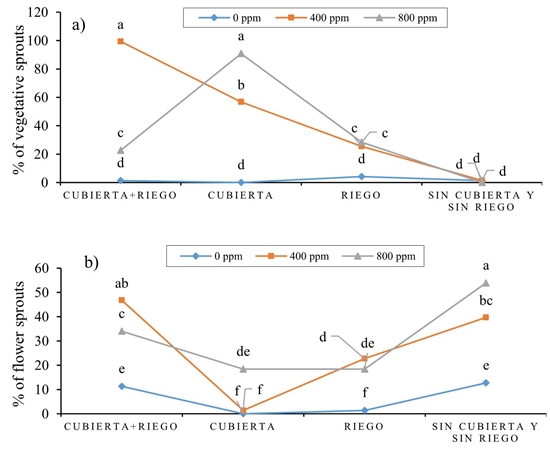
Figure 5 Percentage of vegetative sprouts (a); and flowers (b) 44 days after the application of the dose of TDZ and plastic cover with irrigation in prickly pear cactus ‘Roja purpura’. The lines represent the means and the equal letters are not statistically significant Tukey (p≤ 0.05).
In the end, the highest percentage of flower sprouts occurred in the treatment of 800 ppm of TDZ with 53.9% and covered with irrigation with 400 ppm of TDZ with a sprouting of 46.8% (Figure 5b), surpassing the results obtained by Aguilar (2005) with 5% vegetative and 42.3% floral, making rings in ‘Tlaconopal’ prickly pear cactus.
From 22 to 37 days after applying the TDZ, the cover treatments began to decrease the percentage of flower sprouts and increase the vegetative ones, it is suggested that this was caused by the effect of the temperature of the plastic cover (Figure 6), According to Avitia and Castillo (2007) reported, there is a floral reversal when exposing the plants in the bud development stage to high temperatures, in vine plants. The data found suggests continuing to study the initial effect of heat on the environment and its relationship with Thiadizuron in the stimulation of the nopal flower sprouting.
Yield
Fruits of 6 treatments were obtained, since the plants that were managed with canopy cover or irrigation and their respective dose of TDZ (400 and 800 ppm) did not have prickly pears, due to the fall of mother cladodes due to the excessive weight of new cladodes sprouted (Figure 7) and also due to floral reversal. Due to the lack of fruits in all the treatments, the yield values were estimated and a descriptive analysis was performed.
The highest yields were obtained in the cover treatment with irrigation and 400 ppm of TDZ with a weight of 2193.6 g cladode-1, this value contrasts with the control that had a yield of 339.7 g cladode-1 (Table 1) , this response could be due to the effect of the application of TDZ, in conditions of canopy cover and irrigation, which exceeds the data reported by Valdez et al. (2013) with 1 186 g cladode-1.
Table 1 Estimated yield of the harvested fruits.
Treatment |
Number (Fruits cladode-1) |
Weight (g fruits-1) |
Yield (g cladode-1) |
Yield (kg plant-1) |
Yield (t ha-1) |
Control |
5 |
67.9 |
339.7 |
4 |
3.3 |
400 ppm |
13 |
138.5 |
1 801.1 |
21.6 |
17.9 |
800 ppm |
15 |
140.2 |
2 103.2 |
25.2 |
20.9 |
4 |
78.6 |
3 14.6 |
3.7 |
3 |
|
36 |
60.3 |
2 193.6 |
26.3 |
21.9 |
|
18 |
65.9 |
1 186.9 |
14.2 |
11.8 |
C= cover; R= irrigation.
Martinez et al. (2001) presented varied yields according to cladode markers, when removing 25% of the stalk obtained 16 kg plant-1, pruning 50% 46 kg plant-1 and with the elimination of 75% 76 kg plant-1. Also Zegbe and Mena (2006) obtained yields in a first flowering of 48.3 kg plant-1 later they induced a second flowering eliminating all the vegetative and floral sprouts of the same year, of this second flow, they reported 16.7 kg plant-1. Pinedo et al. (2010) obtained a prickly pear productivity for refrigeration-refrigeration of 30 t ha-1.
Fruit weight
The fruits with the highest weight were harvested from the 800 ppm TDZ treatment, with 140.2 g, surpassing the control with fruits of 67.9 g, it is suggested that this was the cause of rainfall in June and July, since the fruits obtained from treatments with cover presented approximate weights to the control (Table 1) (Gugliuzza et al., 2002); however, Corrales and Hernández (2005) reported higher weight in ‘Cristalina’ prickly pear with 220 g seed and 180 g seedless treated with 150 mg L-1 of gibberellic acid (Zegbe and Mena, 2008).
They obtained fruits of prickly pear ‘Cristalina’ of 188.5g in the first flowering of April-May, while in the second flowering of September-October, induced by the elimination of cladodes and floral meristems, they harvested fruits of 202.5g Aquino et al. (2012) characterized fruits of varieties Opuntia spp. ‘Rojo púrpura’ reporting weight of 160.37 g, Ochoa and Guerrero (2013) obtained fruits of the‘ Blanca’ prickly pear weighing 99.17 g. And Varela et al. (2018) inducing parthenocarpy, they harvested ‘Cristalina’ prickly pear of 137.8 g and ‘Burrona’ 140.8 g.
Conclusions
The effect of the combination of the plastic cover, irrigation with 400 ppm of TDZ and cover, irrigation with 800 ppm of TDZ, significantly increased the floral budding of the periphery and sides of the cladodes, however, the plastic covers increased and maintained the temperature at 26 °C, which could have caused that 22 days after applying the TDZ, the plants with canopy cover presented floral reversal, decreasing the percentage of flower sprouts.
Acknowledgments
To the National Council of Science and Technology (CONACYT) and the College of Postgraduates for resources and funding for research.
REFERENCES
Aguilar, B. G. 2005. Producción forzada de nopal (Opuntia-ficus indica), cv. Tlaconopal mediante anillado parcial. Rev. Fitotec. 28(3):295-298 pp. [ Links ]
Aquino, B. E. N.; Chavarría, M. Y.; Chávez, S. J. L.; Guzmán, G. R. I.; Silva, H. E. R. y Verdalet, G. I. 2012. Caracterización fisicoquímica de siete variedades de tuna (Opuntia spp.) color rojo-violeta y estabilidad del pigmento de las dos variedades con mayor concentración. Rev. Investig. Cienc. 20(55):3-10. [ Links ]
Avitia, G. E. y Castillo, G. A. M. 2007. Desarrollo floral en frutales. Universidad Autónoma Chapingo (UACH). Texcoco, Estado de México. 26-39 pp. [ Links ]
Corrales, G. J. y Hernández, S. J. L. 2005. Cambios en la calidad postcosecha de variedades de tuna con y sin semilla. Rev. Fitotec. Mex. 28(1):9-16. [ Links ]
Domínguez, G. I. A.; Granados, S. M. R.; Sagarnaga, V. L. R.; Salas, G. J. M. y Aguilar, A. J. 2017. Viabilidad económica y financiera de nopal tuna (Opuntia ficus-indica) en Nopaltepec, Estado de México. Rev. Mex. Cienc. Agrar. 8(6):1371-1382. [ Links ]
Estación Agrometeorológico. 2018. Colegio de Postgraduados en Ciencias Agrícolas-Campus Montecillo. [ Links ]
Gallegos, V. C. y MéndezG. S. 2000. La tuna: criterios y técnicas para su producción comercial. Primera edición. Universidad Autónoma Chapingo (UACH)-Fundación PRODUCE Zacatecas-Colegio de Postgraduados. Chapingo, Estado de México. 64 p. [ Links ]
Gugliuzza, G.; Inglese, P. and La Mantia, T. 2002. Relationship between fruit thinning and irrigation on determining fruit of cactus pear (Opuntia ficus-indica) fruit. Acta Hort. 581(1):205-209. [ Links ]
Luna, V. J.; Zegbe, D. J.A.; Mena, C. J. y Rivera, L. M. T. 2012. Manejo de plantaciones de nopal tunero en el altiplano potosino. Instituto Nacional de Investigación Forestales, Agrícolas y Pecuarias (INIFAP). Folleto para productores. 59(2):22-25. [ Links ]
Márquez, B.; Torcuato, S. R.; Almaguer, C. C.; Colinas, V. G.; L. M. T. y Khalil, G. A. 2012. El sistema productivo del nopal tunero (Opuntia albicarpa y O. megacantha) en Axapusco, Estado de México: problemática y alternativas. Rev. Chapingo Ser. Hortic. 18(1):81-93. [ Links ]
Martínez, G.; López, J. C.; Cruz, J. A.; H., J. P. and Delgado, A. A. 2001. Pruning and sprouting season in prickly pear cladodes. Agrociencia. 35(2):159-167. [ Links ]
Muñoz, Z. L.; Méndez I. y Jacinto, R. M. R. 1994. Producción invernal de nopal verdura (Opuntia ficus-indica var Atlixco), bajo microtúnel usando dos tipos de plástico como cubierta; en Xaloztoc, Tlaxcala, México. Rev. Chapingo Ser. Hortic. 2(1):153-156. [ Links ]
Ochoa, V. C. E. y Guerrero, B. J. A. 2013. Efecto de la temperatura de almacenamiento sobre las características de calidad de Tuna Blanca Villanueva (Opuntia albicarpa). Rev. Iberoam. Tecnol. Postc. 14(2):149-161. [ Links ]
Pimienta, B. E.; Barbera, G. and Inglese, P. 1993. Cactus pear (Optunia spp.) international network: an effort for productivity and enviromental conservation for arid and semiarid lands. Revista Cactus and Succulent Journal. 5(65):225-229. [ Links ]
Pinedo, E. J. M.; Bañuelos, F. A. F. y Hernández, F. A. D. 2010. Comportamientos poscosecha de cultivares de tuna por efecto del manejo de huerto y temperatura de frigoconservación. Rev. Iberoam. Tecnol. Postc. 11(1):43-58. [ Links ]
Ramírez, A. O.; Figueroa, H. E. y Espinosa, T. L. E. 2015. Análisis de rentabilidad de la tuna en los municipios de Nopaltepec y Axapusco, Estado de México. Rev. Mex. Agron. 36(1):1199-1210. [ Links ]
SAS Institute. 2013. Base SAS 9.4 Procedures guide: statistical procedures. Second edition. SAS Institute Inc. Cary, NC, USA. 500 p. [ Links ]
SIAP. 2016. Servicio de Información Agroalimentaria y Pesquera. http://www.siap.sagarpa.gob.mx/. [ Links ]
Valdez, C. R. D.; Méndez, G. S. de J.; Magallanes, Q. R.; Ojeda, B. D. L. y Blanco, M. F. 2013. El rendimiento de fruto por cladodio depende de sus atributos físicos en Opuntia ficus-indica (L.) Miller variedad ‘Rojo pelón’. Rev. Chapingo Ser. Hortic. 20(2):131-146. [ Links ]
Varela, D. O. E.; Libera, M. M.; Muratalla, L. A. y Carrillo, S. J. A. 2018. Inducción de partenocarpia en Opuntia spp. Rev. Fitotec. Mex. 41(1):3-11. [ Links ]
Zegbe, D. J. A. y Mena, C. J. 2006. Modificación de la floración, maduración y época de cosecha del nopal tunero (Opuntia spp.). Instituto Nacional de Investigaciones Forestales, Agrícolas y Pecuarias (INIFAP). Guía científica núm. 8. 2-24 pp. [ Links ]
Zegbe, D. J. A. y Mena, C. J. 2008. Retraso de la cosecha en nopal tunero cv. Cristalina. Rev. Chapingo Ser. Hortic. 14(1):85-90. [ Links ]
Received: January 01, 2020; Accepted: March 01, 2020











 texto em
texto em 


